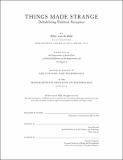Things made strange : de︠st︡abilizing habitual perception
Author(s)
Van de Velde, Floor
DownloadFull printable version (27.73Mb)
Alternative title
De︠st︡abilizing habitual perception
Other Contributors
Massachusetts Institute of Technology. Department of Architecture.
Advisor
Azra Akšamija.
Terms of use
Metadata
Show full item recordAbstract
Technology mediates our perception of the world. The tools of contemporary society's digital habit aim for transparency, creating an inextricable link between the human body, perception and life-world. The resulting entanglement between humans and technology challenges the sensorium: illusion and reality seem to co-exi︠st︡, space and time become compressed, and human relationships transmute into constant digital conne︠ct︡ctions. This intimate yet tenuous bond with technology can automize perceptual processes, leading to habitual perception: we recognize the world around us, but we cease to really see what is there. We are increasingly in danger of losing sight of how we exist within a technologically saturated environment, how we cultivate our curiosity, how we create, how we perceive, and ultimately: how we ought to move forward without losing the sense of how we relate to each other and who we are as humans. Art has the ability to subvert, highlight, and elucidate our tenuous relationship with technology, and to defamiliarize, "make ︠st︡range," and shake up automized and habitual processes of perception as to re-e︠st︡ablish a critical awareness of perception and perceptual processes. In this thesis, I explore the creative strategy of defamiliarization in my own pra︠ct︡ice and regard the works that I have produced at MIT as experimental and experiential frameworks that have the capacity generate the awakening of critical awareness of perception. Besides providing documentation of proje︠ct︡s, these texts may be also be read as a non-linear record of the research, questions, and experiments related to the philosophy of technology, the relationship between art and technology, and the perceptual processes linked to experiential art.
Description
Thesis: S.M. in Art, Culture, and Technology, Massachusetts Institute of Technology, Department of Architecture, 2014. This electronic version was submitted by the student author. The certified thesis is available in the Institute Archives and Special Collections. Cataloged from student-submitted PDF version of thesis. "June 2014." Includes bibliographical references (pages 112-116).
Date issued
2014Department
Massachusetts Institute of Technology. Department of ArchitecturePublisher
Massachusetts Institute of Technology
Keywords
Architecture.